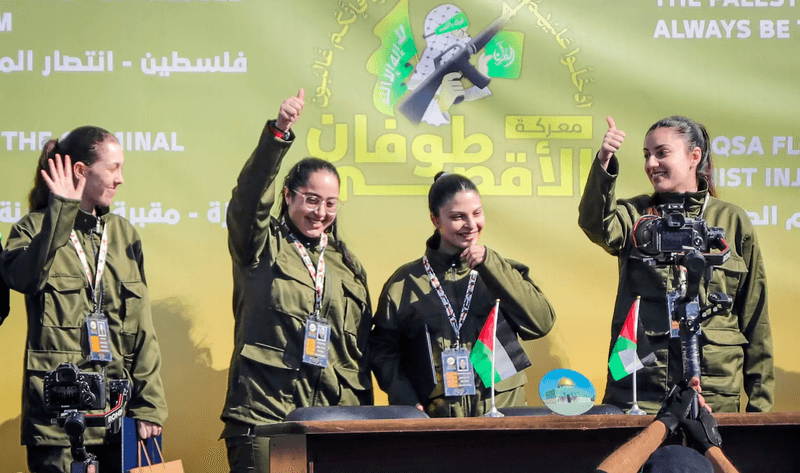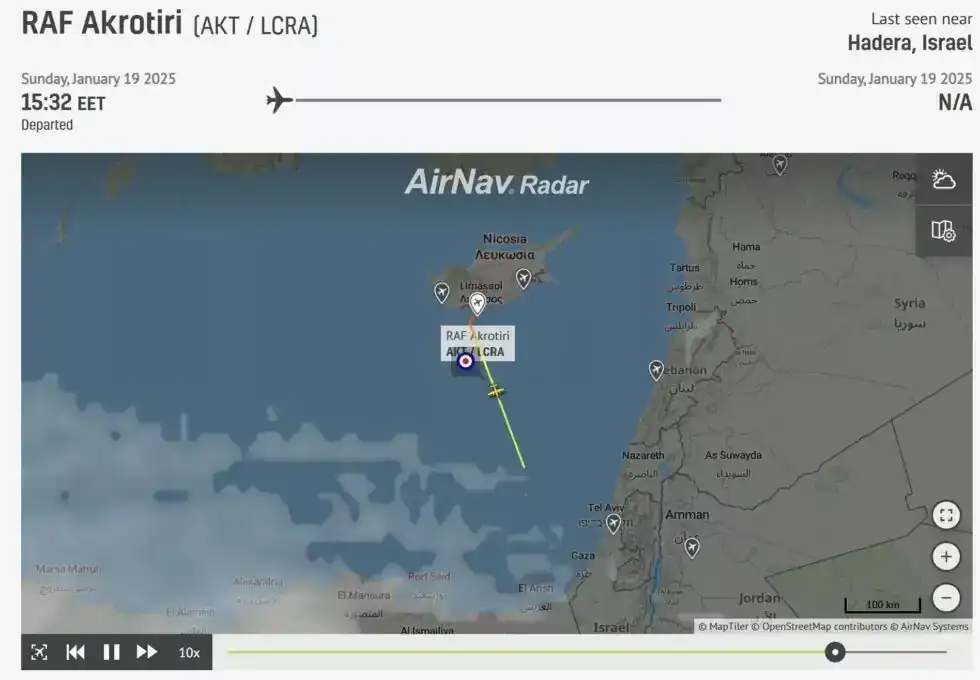Britain’s Royal Air Force (RAF) has dispatched two surveillance planes towards Gaza since the ceasefire between Israel and Hamas began, Declassified can reveal.
Both flights took place while hostages were in the process of being exchanged.
The Foreign Office says the surveillance aircraft are “unarmed” and “tasked solely to locate hostages”, raising serious questions about why spy planes are still being sent to the region while hostages are being released.
Zaki Sarraf, a legal officer at the International Centre of Justice for Palestinians (ICJP) told Declassified: “For months, the government has said that RAF planes flying around Gaza are used solely for locating hostages, so why are these flights still happening now that hostilities have paused?”
The first spy flight departed from RAF Akrotiri, Britain’s airbase in Cyprus, at 15:32 and returned at 20:59 local time on 19 January – the day the ceasefire went into effect.
The aircraft turned off its transponders over the eastern Mediterranean, raising questions about precisely what it was doing in the air while the last remaining British hostage, Emily Damari, was being released by Hamas.
The second flight departed from RAF Akrotiri on 25 January at 11:26 local time and returned to base at 17:44, once again turning off its transponders over the eastern Mediterranean as the second hostage exchange was taking place.
Britain’s Ministry of Defence told Declassified that the aircraft “did not enter Gazan airspace and at all times operated in accordance with the ceasefire and hostage release agreement between Israel and Hamas”.
This denial would not preclude the RAF’s Shadow R1 spy plane from having collected surveillance footage on hostage movement from Israeli airspace or conducted further intelligence gathering in support of Israel elsewhere.
The Ministry of Defence did not respond to Declassified’s questions on whether the spy planes gathered intelligence on Gaza from Israeli airspace.
Intelligence sharing
The spy flights have been shrouded in secrecy since they were first dispatched to Gaza in December 2023, and campaigners are now calling for an inquiry into Britain’s intelligence sharing with Israel.
Sarraf, from the ICJP, commented: “The Shadow R1 planes being used are specialised in target acquisition. It’s unclear why they were being used in the first place, but their continued use – despite the exchange of hostages already underway – raises even more serious concerns about their true purpose”.
He added: “The British public deserves clarity. A comprehensive, public inquiry into the UK’s complicity in Israel’s genocide against the Palestinians is urgently needed, including on these flights. Accountability is simply non-negotiable – the stakes are too high”.
Ceasefire
The text of the original ceasefire agreement between Israel and Hamas notes that in the first phase: “All aviation (military and reconnaissance) in the Gaza strip shall cease for 10 hours a day, and for 12 hours on the days when captives and prisoners are being exchanged”.
This stipulation was not only designed to offer Palestinians respite from Israeli bombardment, but also assure Hamas that Israel will not collect intelligence on hostage movements and locations.
While the UK is not a signatory to the ceasefire agreement, Hamas said the spy flights made Britain “an accomplice to the Zionist occupation” when they were launched in December 2023.
The decision to send spy flights to the region during hostage exchanges might therefore raise suspicions that Britain has violated the spirit, if not the letter, of the ceasefire.
It also raises the prospect that UK-supplied surveillance footage could be used by Israeli forces to conduct future military operations in Gaza.
The Shadow R1 planes can gather information for “target acquisition”, and intelligence received from Israel ahead of the missions may have been obtained under torture.
A previous Israeli “hostage rescue” operation involved the killing of 274 Palestinians situated in the Nuseirat refugee camp. The Ministry of Defence subsequently refused to say whether RAF surveillance footage had been used in the operation.
British hostages
Three hostages were released by Hamas while the first spy plane was overflying the region including 28-year-old Emily Damari, the last remaining British hostage in Gaza.
It was peace negotiations rather than spy flights which secured Damari’s release, putting into question the fundamental reason for continuing to dispatch spy flights from RAF Akrotiri.
One of Britain’s surveillance planes, with tail number ZZ507, remains stationed at RAF Akrotiri. It is unclear when it will finally return to its base at RAF Waddington.
Declassified previously revealed that the RAF has flown hundreds of spy missions over Gaza in support of Israel.
None of them resulted in the release of British hostages, with the only other UK national – Nadav Popplewell – dying last year during Israeli military operations in Gaza.
Naledi Pandor, who was South Africa’s foreign minister when it accused Israel of genocide at the International Court of Justice, has previously told Declassified that the flights were “collusion with what has been called a crime against humanity”.
Image: UK spy flights near Gaza – officially meant to locate hostages – have continued even as Israeli soldiers were freed by Hamas on Saturday. (Photo: Abed Hajjar / Alamy).




